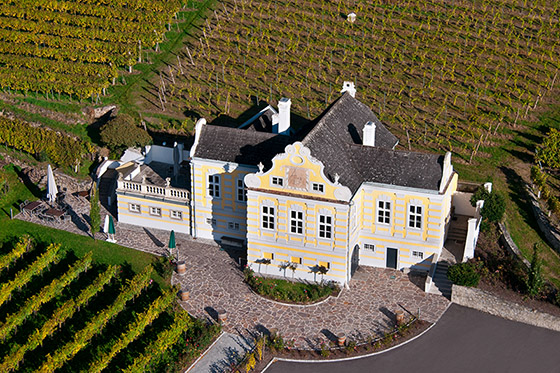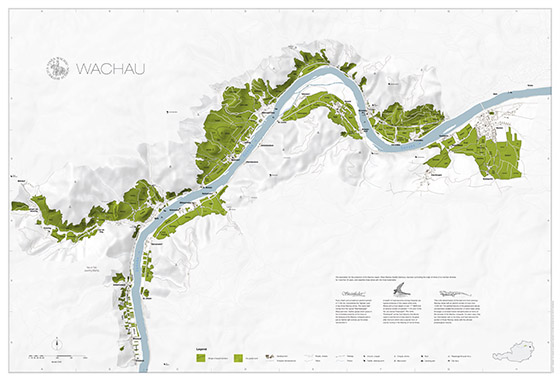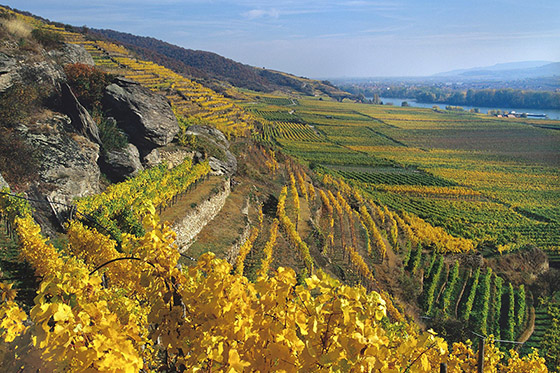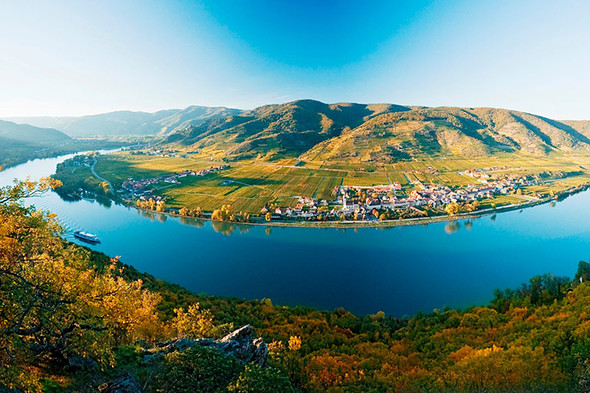Austrian Wachau is a cultural landscape which makes you want to returns year after year. You could say that it is a must-see, and not just for wine-drinkers. In this respect, however, it fits in with the imaginary line which is formed by the Douro Valley in Portugal, the Mosel and Rhine Valleys in Germany and Tokaj in Hungary. The main characteristics of these wine regions is that they are situated next to rivers and man has shaped the landscape (through the vineyards) to the form in which they can be seen today. In addition, in such a way that they are so beautiful as to be almost inconceivable. Well, this text has become rather sentimental; you must feast your eyes on Wachau and that’s all there is to it!

The name of Wachau was, of course, not always as obviously synonymous with quality as it is today. The second volume (Vienna and Lower Austria, 1888) of the 21-volume series “The Austrian-Hungarian Monarchy in words and images”, published at the end of the 19th century, wrote about the region’s wines:
The wines from Klosterneuburg and Nussdorf have long been recognised as the best white wines, which is mostly thanks to the chapter. These are followed by the wines from Gumpoldskirchen and Bisamberg, which are characterised by a pleasant taste. Those from Krems and Retz as well as from Meilbert and Stinkenbrunn belong amongst the great white table wines; the production of good average wines, amongst which the Brünnerstrassen and the Feldsberg are the best, whereas the wines from Wachau belong amongst the less good, are partly for ordinary consumption and partly to mix with lighter Hungarian wines, which are suitable for that purpose.
Even at that time it was not yet clear, and then a hundred years later even less, that Wachau would put Austria onto the world wine map. Yet this is what happened.
Before the map
Have you already drunk Austrian Grüvee and liked it? That’s no wonder. There’s a good chance that the wine you liked came from the Wachau wine region, which is located next to the river Danube in Austria, Central Europe. 85 km to the west of the country’s capital, Vienna, the Danube gets trapped between the hills and traces wonderful bends. The sides of the hills on the south bank are decorated with hundreds-of-years-old stone terraces, where the locals cultivate grapes. This is the Wachau wine region, which is bounded by two cities, Melk in the West and Krems in the East. The region’s main settlements are Dürnstein, Rossatz, Weissenkirchen and Spitz, but Willendorf is also almost as well known. True, not for the wine, rather for the 30,000-year-old figurine, the Venus of Willendorf.

33 years of history
In the 1980s, a serious wine fraud scandal erupted in Austria, fundamentally shaking the country’s wine production. The subsequent reconstruction was rapid and not at all painless. This story concerns Wachau too in that in 1983 the local producers established the Vinea Wachau organisation and created the Codex Wachau, a strict quality and origin protection system still in use today. The essence of this is that wines marketed under the Wachau name may only be produced from grapes originating in the wine region and may also only be bottled within the wine region. Moreover, adding sugar or concentrated must to the wine is not permitted, nor is changing the natural aromatics of the wine, thus the use of new oak is forbidden, and hand-harvesting is mandatory!
In addition, they created a three-tier system, which, even within Austria, is only used here and represents a useful and significant help when buying wine, even if you have never come across Wachau wine before. (The system only covers dry wines!)
1.Steinfeder
Fruity charm and a stipulated maximum alcohol content of 11.5% by volume characterize the lightest style of top Vinea Wachau wines - the Steinfeder®. The name itself refers to the typical "Steinfedergras” (Stipa pennata), a grass which grows near the vines in the Wachau´s terraced vineyards; it is light like a feather, and fragrant – just like the wine named after it.
2.Federspiel
This classic dry wine is distinguished by a strong, nuance-rich character. Federspiel® wines feature a must weight of at least 17° KMW and an alcohol content of between 11.5% and 12.5% by volume. The name Federspiel refers back to the times of falconry, when this favourite form of noble hunting was practiced in the Wachau.
3.Smaragd
Smaragd is the name for the best, most treasured wines from the Vinea Wachau members. The alcohol content of these wines begin at 12.5% by volume. This, along with the highest grape ripeness and natural concentration are what make this world-class designation possible. Emerald-coloured lizards – also known as Smaragd - are at home in the terraced vineyards of the Wachau. On bright, sunny days, their beauty is highlighted dramatically as they bask in the gleaming sun next to the grapevines – the perfect symbol for the absolute top Wachau wines with full physiological ripeness.
It would be a mistake to think that this regulation is about alcohol content, although this does play a role too. The main point is that different categories should display various flavours. If we try to simplify this, then Steinfelder, with its low alcohol content and high acidity, is well suited to today’s increasingly light wine category. Federspiel demonstrates perfectly the different characteristics of the vineyards, but typically does this without botrytis, whilst grapes are harvested at perfect ripeness for Smaragd, and often with botrytis. The latter obviously only happens in the best-located vineyards and the alcohol content of these wines often reaches 14% too.

It may all seem rather complicated, but once you spend a little time on it, you realise how logical the whole thing is. What may complicate things further for the consumer is the vineyards. If you are familiar with Burgundy, you know what I’m talking about. If you don’t, here it is in brief. There are some wines where just the wine region is named. Then there are those which indicate the name of the village; here there is already a basic rule that the grapes must come from vineyards belonging to that village. Finally, there are vineyards whose vines are precisely delineated.
124 vineyards are delineated in Wachau (these also appear on the wine region’s official map), which is brought up to 159 together with the sub-vineyards. In other words, you can find 159 different names on the label. Furthermore, all three categories of dry wine can, in theory, be produced from each vineyard; moreover, all three categories can be made from any permitted variety, and even sweet wine too.
A special category, which is not, however, geographic, is the Terrassen, which can be Steinfelder, Federspiel and Smaragd too; this simply means that the grapes come from the steep, terraced vineyards.
Is there anything else I should know?
Of course, there is! The two main grape varieties are GV and Riesling, but producers also work with other varieties and, in addition to white wines, they also make rosé and red wine in the region. Of course, you might also come across sweet wines and orange wines, but Wachau’s protection of origin, we’re safe in saying, is all about the dry wines produced from the two main varieties.






